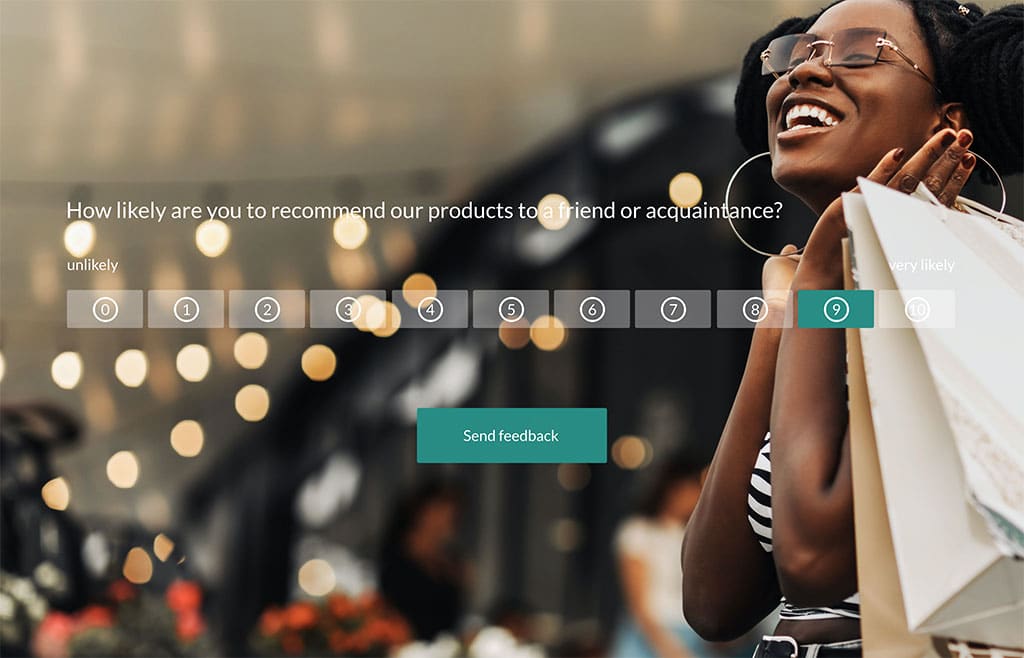
Measurably increase customer satisfaction through real-time surveys and feedbacks






Sustainably successful companies from the e-commerce and retail sectors recognized the potential of surveys a long time ago and use them consistently. You too can identify and enhance the experience of your customers at every touchpoint of the customer experience. And find out how enthusiastic your customers are about the product range, the service or your online store.
Challenges of e-commerce and retail
1. Digitize manual processes
From assortment planning to demand determination and purchasing to deadline monitoring: many such processes are still carried out manually in medium-sized companies today. Digitizing these processes poses massive challenges for many companies. Once implemented, however, digitally consistent processes mean a great reduction in workload and thus more time for ensuring customer satisfaction.
2. Increasing competition
Increasing competition – price war – high customer expectations.
To stand out from the competition, it is more important than ever to offer customers a unique shopping experience. This calls for eye-catching ideas and exceptional service that impresses customers and creates lasting loyalty. But what to invest in first? With easyfeedback and the results from the surveys, budgets can be planned and deployed in a targeted manner.
3. (Online) marketing
Market-oriented management with an eye for the needs of potential new customers and the potential of existing customers are, among other things, the core elements of effective marketing. Increasing the number of visitors and the number of sales is also one of the challenges of marketing.
However, many corporate marketers do not know their target audience or their wants and/or needs. In addition, trends change quickly, which puts many marketers under enormous pressure.
4. Strengthen customer loyalty
Competitive pressure and customer requirements are constantly increasing. Customers expect more service and shorter delivery times at the same or, at best, lower costs. The World Wide Web also makes it easy for buyers to compare different providers directly online. Negative experiences, which can be caused by unpunctual deliveries or complicated returns processes, for example, quickly lead to a loss of trust in the selected company. This loss of trust affects customer satisfaction and loyalty and leads, in the worst case, to a product purchase from the competition or, in the best case, to a negative review in online rating platforms.
Companies are therefore now more than ever faced with the challenge of offering needs-based offers at the right time so that customers feel connected and interact with the company.
In order to bind a buyer to a company in the long term, various customer loyalty instruments are used. The right measure in each case varies from company to company. It is the challenge of each company to find out which measures help to achieve the set goals.
5. High return rates
There’s no question about it: e-commerce is booming. But with it, the return rate is also skyrocketing. Too big, too small, the color isn’t right, the fabric is unpleasant, so everything is returned.
For companies, returns mean an enormous loss that is incalculable in advance, as they have to bear logistics and personnel costs in addition to outbound and return shipping. The returned goods have to be checked manually after being sent back and, if necessary, relabeled or ironed. In some cases, goods can only be resold as B-goods or not at all.
But the high return rate does not only have negative consequences for companies. Our environment also suffers enormously. Among other things, the high carbon dioxide emissions for reshipping lead to climate damage.
One of the biggest challenges facing companies is to reduce the frequency of returns without suffering any disadvantages, for example due to customers leaving the company.
6. Further training of employees
New work processes, changes in job profiles and the use of new technologies lead to a constant need for further training for e-commerce and retail employees.
In addition, customers are becoming increasingly demanding. Regular sales training should have a positive influence on the quality of consulting. However, identifying which employees have a need for further training in the first step already challenges many companies and decision-makers.
Range of application of questionnaires in e-commerce and retail
Don’t wait until dissatisfied customers leave, but prevent this before it happens. With short surveys, you can obtain cost-effective, targeted and fast feedback on the products and services offered as well as the shopping experience and thus strengthen satisfaction and customer loyalty through suitable measures.

Measure purchase experience & customer satisfaction
Satisfied customers are the key to success: Whether online or on site, when customers shop, they want to experience a positive buying experience that is fully aligned with their needs and preferences. Friendly and attentive staff, good and competent advice, a wide and rich assortment and a smooth process are important factors that positively influence the experience and also customer satisfaction.
Use surveys to easily find out how your customers are satisfied and what kind of shopping experience you offer. Which aspects are causing problems and which potentials can be further developed. Based on the feedback, you can exceed your customers’ expectations and ensure a sustainable buying experience.

Check smooth running of processes
Where do bottlenecks occur within your processes? Do the handovers between different departments run smoothly or is there potential for improvement here? When do products have to be reordered to avoid delivery problems?
Queries about the progress of your processes help you to uncover potential problems at an early stage and to take appropriate precautions.

Customize product range & offers
Do the products offered meet the needs and demand situation of your customers? What is currently in vogue and therefore in particular demand?
Use a customer survey to find out how your product range is received, whether your customers are missing something and whether you need to adapt your offerings.

Conduct market and competitive analyses
Who are your customers? What is their consumption and purchasing behavior? Why do they buy from you? What alternative shopping options do they have and what does the competition do better?
Market and competitive analysis help you understand what is going well or what the competition is doing better.

Advantages of surveys with easyfeedback
Find out quickly and easily how your company’s customer satisfaction is doing with easyfeedback. Act according to the motto: “He who doesn’t ask, doesn’t win!” and give your customers what they want.
easyfeedback offers you the possibility to find out about the wishes and expectations of your customers with just a few clicks using a simple survey or how to support manual workflows with digital forms.
- Feedback in real time
- Flexible application possibilities
- Extensive evaluation options
- Link surveys to over 2,000 of the most popular apps

Avosax GmbH

Züblin AG


